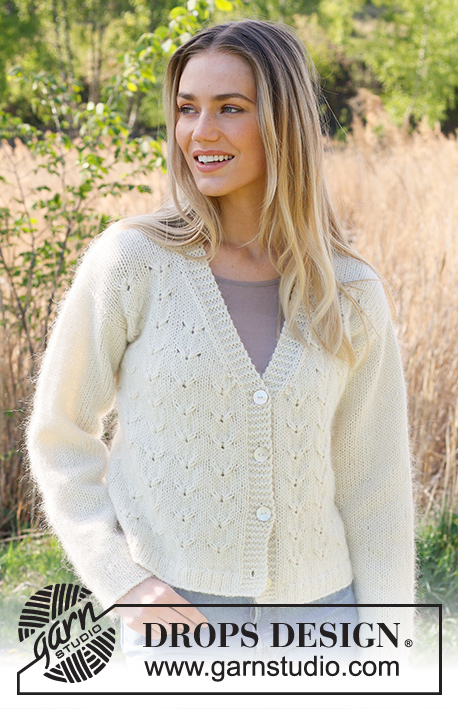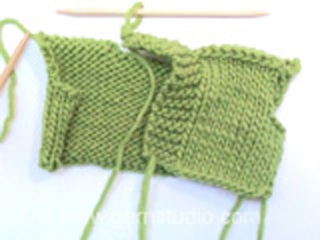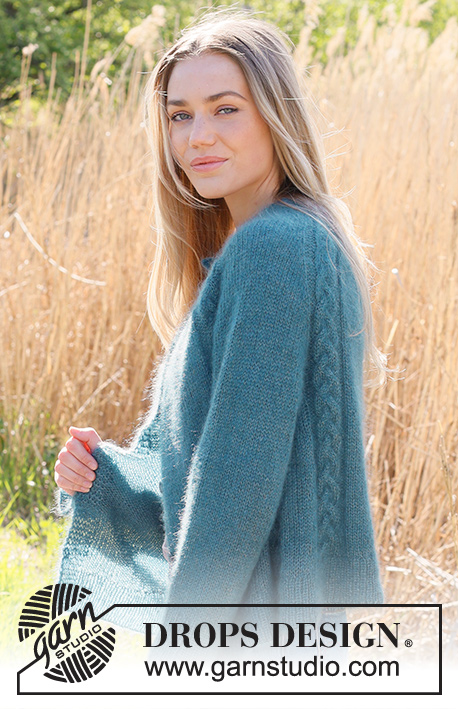Southern Migration Cardigan |
|||||||||||||||||||
 |
 |
||||||||||||||||||
Knitted jacket in DROPS Merino Extra Fine and DROPS Kid-Silk. The piece is worked bottom up with relief-pattern, V-neck and sewn-in sleeves. Sizes S - XXXL.
DROPS 235-14 |
|||||||||||||||||||
|
------------------------------------------------------- EXPLANATIONS FOR THE PATTERN: ------------------------------------------------------- RIDGE/GARTER STITCH (worked back and forth): Knit all rows. 1 ridge = knit 2 rows. PATTERN: See diagram A.1. The diagram shows all rows in the pattern from the right side. DECREASE TIP (V-neck): All decreases are worked from the right side. When there isn’t room for a complete repeat of the pattern towards the neck, work stockinette stitch over the remaining stitches. LEFT FRONT PIECE: Work until there are 9 stitches left on the row, knit 2 together, knit 1 and 6 band stitches in garter stitch. RIGHT FRONT PIECE: 6 band stitches in garter stitch, knit 1, slip 1 stitch as if to knit, knit 1 and pass the slipped stitch over the knitted stitch. INCREASE TIP (sleeves): Work until there are 2 stitches left before the marker, 1 yarn over, knit 4 (marker sits between these 4 stitches), 1 yarn over. On the next round knit the yarn overs twisted to avoid holes. Then work the new stitches in stockinette stitch. BUTTONHOLES (bottom up): Work the buttonholes on the right band. 1 BUTTONHOLE = knit together the 3rd and 4th stitch from the edge, make 1 yarn over. On the next row knit the yarn over to leave a hole. Work the buttonholes when the piece measures: S: 5, 14, 23 and 32 cm = 2", 5½", 9" and 12½". M: 6, 15, 24 and 33 cm = 2⅜", 6", 9½" and 13". L: 6, 13, 20, 27 and 34 cm = 2⅜", 5⅛", 8", 10⅝" and 13⅜". XL: 4, 12, 20, 28 and 36 cm = 1½", 4¾", 8", 11" and 14¼". XXL: 5, 13, 21, 29 and 37 cm = 2", 5⅛", 8¼", 11⅜" and 14½". XXXL: 5, 13, 21, 29 and 37 cm = 2", 5⅛", 8¼", 11⅜" and 14½". ------------------------------------------------------- START THE PIECE HERE: ------------------------------------------------------- JACKET – SHORT OVERVIEW OF THE PIECE: The body is worked back and forth bottom up on circular needle. The piece is divided for the armholes and the front and back pieces finished separately. The sleeves are worked in the round with double pointed needles/short circular needle. BODY: Cast on 206-221-239-257-278-299 stitches with circular needle size 4 MM = US 6 and 1 strand DROPS Merino Extra Fine and 1 strand DROPS Kid-Silk. Purl 1 row from the wrong side. Work the next row from the right side as follows: 6 band stitches in GARTER STITCH – read description above, work rib (knit 2, purl 1) until there are 6 stitches left and 6 band stitches in garter stitch. Continue this rib for 4 cm = 1½" and the next row is from the right side - read BUTTONHOLES. Change to circular needle size 5.5 MM = US 9. Knit 1 row from the right side and decrease 21-24-26-28-29-30 stitches evenly spaced (do not decrease over the bands) = 185-197-213-229-249-269 stitches. Purl 1 row from the wrong side (bands are knitted). Then work as follows from the right side; remember the BUTTONHOLES on the right band – read description above: 6 band stitches in garter stitch, work A.1 over the next 36-36-45-45-54-54 stitches, 2-5-0-4-0-5 stitches in stockinette stitch, A.1 over 9 stitches, 2-5-0-4-0-5 stitches in stockinette stitch, A.1 over the next 72-72-90-90-108-108 stitches, 2-5-0-4-0-5 stitches in stockinette stitch, A.1 over 9 stitches, 2-5-0-4-0-5 stitches in stockinette stitch, A.1 over the next 36-36-45-45-54-54 stitches, 3 stitches in stockinette stitch, 6 band stitches in garter stitch. Insert 2 markers, 50-53-57-61-66-71 stitches in from each side (85-91-99-107-117-127 stitches between the markers on the back piece); allow the markers to follow your work onwards. Continue this pattern until the piece measures 33-34-35-36-37-38 cm = 13"-13⅜"-13¾"-14¼"-14½"-15" from the cast-on edge – adjust so the next row is row 7 or 1 in A.1 (this gives you a neat pattern along the V-neck). Start to decrease for the neck AT THE SAME TIME as you bind off for the armholes as follows from the right side: 6 band stitches in garter stitch, 1 stitch in stockinette stitch, purl 3 together, work as before until there are 2-3-6-8-11-15 stitches left before the marker, bind off 4-6-12-16-22-30 stitches, work as before until there are 2-3-6-8-11-15 stitches left before the marker, bind off 4-6-12-22-30 stitches, work until there are 10 stitches left, purl 3 together, knit 1 and 6 band stitches in garter stitch. The front and back pieces are finished separately. LEFT FRONT PIECE: = 46-48-49-51-53-54 stitches. Work 1 row from the wrong side as before. Then work as follows from the right side: 6-8-0-2-4-5 stitches in stockinette stitch, A.1 over the next 27-27-27-27-36-36 stitches as before, stockinette stitch until there are 10 stitches left on the row, purl 3 together, knit 1 and 6 band stitches in garter stitch = 44-46-47-49-51-52 stitches. Decrease 1 stitch for the neck on each row from the right side – read DECREASE TIP. Decrease like this a total of 11-11-11-12-11-11 times = 33-35-36-37-40-41 stitches. When the piece measures 44-46-47-49-50-52 cm = 17¼"-18"-18½"-19¼"-19¾"-20½", continue with stockinette stitch – adjust to after a complete repeat in height. AT THE SAME TIME on the first row from the right side decrease 2-2-2-2-3-3 stitches evenly spaced (do not decrease over the band) = 31-33-34-35-37-38 stitches. Continue with stockinette stitch and 6 band stitches in garter stitch until the piece measures 52-54-56-58-60-62 cm = 20½"-21¼"-22"-22¾"-23⅝"-24⅜". On the next row from the right side bind off the first 25-27-28-29-31-32 stitches for the shoulder = 6 stitches. Work garter stitch over these 6 stitches for 7-7-7-8-8-8 cm = 2¾"-2¾"-2¾"-3⅛"-3⅛"-3⅛". Bind off. RIGHT FRONT PIECE: = 46-48-49-51-53-54 stitches. Work 1 row from the wrong side as before. Then work as follows from the right side: 6 band stitches in garter stitch, knit 1, purl 3 together, work to the end of the row as before = 44-46-47-49-51-52 stitches. Then decrease 1 stitch for the neck on each row from the right side – remember DECREASE TIP. Decrease like this a total of 11-11-11-12-11-11 times = 33-35-36-37-40-41 stitches. When the piece measures 44-46-47-49-50-52 cm = 17¼"-18"-18½"-19¼"-19¾"-20½", continue with stockinette stitch – adjust to after a complete repeat in height. AT THE SAME TIME on the first row from the right side decrease 2-2-2-2-3-3 stitches evenly spaced (do not decrease over the band) = 31-33-34-35-37-38 stitches. Continue with stockinette stitch and 6 band stitches in garter stitch until the piece measures 52-54-56-58-60-62 cm = 20½"-21¼"-22"-22¾"-23⅝"-24⅜". On the next row from the wrong side bind off the first 25-27-28-29-31-32 stitches for the shoulder = 6 stitches. Work garter stitch over these 6 stitches for 7-7-7-8-8-8 cm = 2¾"-2¾"-2¾"-3⅛"-3⅛"-3⅛". Bind off. BACK PIECE: = 81-85-87-91-95-97 stitches. Work 1 row from the wrong side as before. On the next row from the wrong side work as follows: 3-5-6-8-1-2 stitches in stockinette stitch, A.1 over the next 72-72-72-72-90-90 stitches, work the first 3 stitches in A.1 and 3-5-6-8-1-2 stitches in stockinette stitch. When the piece measures 48-50-52-54-56-58 cm = 19"-19¾"-20½"-21¼"-22"-22¾", continue with stockinette stitch – adjust to after a complete repeat in height. AT THE SAME TIME on the first row from the right side decrease 6 stitches evenly spaced = 75-79-81-85-89-91 stitches. When the piece measures 50-52-54-56-58-60 cm = 19¾"-20½"-21¼"-22"-22¾"-23⅝" and the next row is from the right side, bind off the middle 23-23-23-25-25-25 stitches for the neck and finish each shoulder separately. LEFT SHOULDER: = 26-28-29-30-32-33 stitches. Start from the wrong side and work as before. On the first row from the right side decrease for the neck as follows: Knit 2, knit 2 together and knit to the end of the row = 25-27-28-29-31-32 stitches. Continue with stockinette stitch. Bind off when the piece measures 52-54-56-58-60-62 cm = 20½"-21¼"-22"-22¾"-23⅝"-24⅜" from the cast-on edge. RIGHT SHOULDER: = 26-28-29-30-32-33 stitches. Start from the wrong side and work as before. On the first row from the right side decrease for the neck as follows: Knit until there are 4 stitches left, slip 1 stitch as if to knit, knit 1 and pass the slipped stitch over the knitted stitch, knit 2 = 25-27-28-29-31-32 stitches. Continue with stockinette stitch. Bind off when the piece measures 52-54-56-58-60-62 cm = 20½"-21¼"-22"-22¾"-23⅝"-24⅜" from the cast-on edge. SLEEVES: Cast on 48-48-51-54-54-57 stitches with double pointed needles size 4 MM = US 6 and 1 strand of each quality (2 strands). Knit 1 round. Work rib (knit 2, purl 1) in the round for 4 cm = 1½". Knit 1 round and decrease 8-6-7-10-8-9 stitches evenly spaced = 40-42-44-44-46-48 stitches. Insert a marker at the beginning of the round (mid-under sleeve). Allow the marker to follow your work onwards – it is used when increasing under the sleeve. Change to double pointed needles size 5.5 MM = US 9 and work stockinette stitch. When the sleeve measures 9-9-9-7-8-6 cm = 3½"-3½"-3½"-2¾"-3⅛"-2⅜", increase 1 stitch on each side of the marker – read INCREASE TIP. Increase like this every 4-3½-3-3-2½-2½ cm = 1½"-1¼"-1⅛"-1⅛"-1"-1" a total of 10-11-12-13-14-14 times = 60-64-68-70-74-76 stitches. When the piece measures 48-47-46-44-43-40 cm = 19"-18½"-18"-17¼"-17"-15¾", divide at the marker and work the sleeve cap back and forth. Bind off when the sleeve measures 50 cm = 19¾" (a split of 2-3-4-6-7-10 cm = ¾"-1⅛"-1½"-2⅜"-2¾"-4" at the top). Work the other sleeve in the same way. ASSEMBLY: Sew the shoulder seams. Sew the bands together mid-back (collar). Sew the collar to the neck-line at the back. Sew the sleeve cap to the armhole, then the split to the bottom of the armhole – see sketch. |
|||||||||||||||||||
Diagram explanations |
|||||||||||||||||||
|
|||||||||||||||||||

|
|||||||||||||||||||

|
|||||||||||||||||||

|
|||||||||||||||||||
|
Have you made this or any other of our designs? Tag your pictures in social media with #dropsdesign so we can see them! Do you need help with this pattern?You'll find tutorial videos, a Comments/Questions area and more by visiting the pattern on garnstudio.com. © 1982-2024 DROPS Design A/S. We reserve all rights. This document, including all its sub-sections, has copyrights. Read more about what you can do with our patterns at the bottom of each pattern on our site. |
|||||||||||||||||||














































































Comments / Questions (14)
Bonjour. Je vous remercie pour la vidéo très explicite. Bonne fin de journée
09.04.2024 - 12:03Bonsoir. Dans les explications pour une taille M il est noté : "Quand l'ouvrage mesure 48-47-46-44-43-40 cm, diviser au marqueur et tricoter la tête de manche en allers et retours. Rabattre quand la manche mesure 50 cm (on a une fente de 2-3-4-6-7-10 cm en haut de la manche)". Sur combien de maille doit on travailler ? Que veut dire diviser au marqueur et la tête de manche ? Merci pour vos explications
08.04.2024 - 21:50DROPS Design answered:
Bonjour Sylvie, en taille M vous tricotez en rond jusqu'à ce que la manche mesure 47 cm de hauteur totale, puis vous tricotez le haut de la manche en allers et retours pendant 3 cm = la manche mesure 50 cm de hauteur totale et le haut /la tête de la manche mesure 3 cm. Découvrez cette façon de faire dans cette vidéo. Bon tricot!
09.04.2024 - 08:50Bonjour. Je vous remercie pour la vidéo très explicite. Bonne fin de journée
02.04.2024 - 18:38Bonjour. Je sollicite votre aide car je n'ai pas bien compris pour faire une maille longue. Merci
01.04.2024 - 15:06DROPS Design answered:
Bonjour Sylvie, cette vidéo devrait alors vous aider, car elle montre comment tricoter ce type de motifs. Notez juste que dans la vidéo, les motifs se répètent plus souvent en hauteur et en quinconce alors qu'ici, vous allez les tricoter en répétant A.1 en hauteur. Bon tricot!
02.04.2024 - 15:19Wat zijn de wasinstructies voor dit vest?? Want die zijn van Merino extra fine en kid silk nogal verschillend.
11.03.2024 - 09:32DROPS Design answered:
Dag Bianca,
Je houdt altijd de instructies van het meest kwetsbare garen aan, alleen in dit geval moet het ene in de wasmachine gewassen worden en het andere met de hand. Lastig inderdaad. Je zou het kledingstuk ook buiten kunnen luchten. Misschien kun je het plat op een rekje neerleggen. Als het een beetje nevelig/mistig buiten is en je legt het een nacht buiten, dan frist het ook behoorlijk op. Hopelijk heb je hier wat aan.
11.03.2024 - 20:58Bonjour \r\nPour la manche, c est noté il il faut diviser au marqueur la tête de manche mais ce n est pas indiqué combien de maille. Vous pouvez m’éclairer à ce sujet ? Merci beaucoup
10.09.2023 - 11:41DROPS Design answered:
Bonjour Capucine, vous divisez l'ouvrage au niveau du marqueur sous la manche et continuez en allers et retours à partir du milieu sous la manche (sans diminuer, autrement dit, tricotez maintenant toutes les mailles en rangs, en commençant au milieu sous la manche, comme avant). Bon tricot!
11.09.2023 - 10:15Can someone give me a clue about sizes? Am I missing something, but I can't find any advice about what the sizes S to XXL mean.
20.08.2023 - 09:29DROPS Design answered:
Dear Honor, the measurements for the sizes can be found in the schematic drawing, after the pattern's charts. You can see here how to read this schematic:https://www.garnstudio.com/lesson.php?id=24&cid=19. The measurements are all in cm. Happy knitting!
20.08.2023 - 17:01Dans les explications en haut pour l encolure il dise 2 mailles ensemble à l endroits et dans les explications plus bas ils disent 3 mailles ensemble à l envers donc je suis un peu perdu
03.03.2023 - 14:58DROPS Design answered:
Bonjour Mme Vorst, on diminue d'abord en tricotant 3 mailles ensemble à l'envers pour l'encolure, puis, on continue en diminuant ensuite 1 seule maille comme indiqué sous DIMINUTIONS. Bon tricot!
03.03.2023 - 15:34Não entendi o diagrama. Qdo se diz pra diminuir, não tem laçada pra compensar a diminuição. ? Se finerentes assim a peça vai encolher
17.02.2023 - 20:05DROPS Design answered:
Bom dia, Não, de facto, não há laçadas neste bonito ponto. Há malhas alongadas que formam os buraquinhos. Tem à sua disposição um vídeo que explica como fazer o ponto com malhas alongadas: https://www.garnstudio.com/video.php?id=1663&lang=pt Bons tricôs!
21.03.2023 - 09:56Bonjour, sauf erreur de ma part, lorsque je fais la règle de 3 avec les références du modèle, je ne trouve pas les mêmes résultats. Ex: les valeurs du point fantaisie sont 17 m =10 cm . Monter 206 m . 206m ×10 =2060/17=121/2=60,5 cm. Sur le patron ça fait 54 cm. Merci de bien vouloir m éclairer sur le mode de calcul . Bien a vous. Nadine
08.02.2023 - 08:44DROPS Design answered:
Bonjour Mme Pinel, en fait les 206 mailles sont celles montées pour tricoter en côtes avec les petites aiguilles, on va ensuite diminuer avant de tricoter le point fantaisie, on aura ainsi 185 m au total sur l'aiguille soit 85 m pour le dos et ainsi on retrouve bien nos 50 cm de large. Bon tricot!
08.02.2023 - 09:21